The A-C linker controls centriole structural integrity and duplication
- PMID: 40707486
- PMCID: PMC12290023
- DOI: 10.1038/s41467-025-62154-6
The A-C linker controls centriole structural integrity and duplication
Abstract
Centrioles are evolutionarily conserved barrel-shaped organelles playing crucial roles in cell division and ciliogenesis. These functions are underpinned by specific structural sub-elements whose functions have been under investigation since many years. The A-C linker structure, connecting adjacent microtubule triplets in the proximal region, has remained unexplored due to its unknown composition. Here, using ultrastructure expansion microscopy, we characterized two recently identified A-C linker proteins, CCDC77 and WDR67, and discovered MIIP as an additional A-C linker protein. Our findings reveal that these proteins localize between microtubule triplets at the A-C linker, forming a complex. Depletion of A-C linker components disrupt microtubule triplet cohesion, leading to breakage at the proximal end. Co-removal of the A-C linker and the inner scaffold demonstrates their joint role in maintaining centriole architecture. Moreover, we uncover an unexpected function of the A-C linker in centriole duplication through torus regulation, underscoring the interplay between these protein modules.
© 2025. The Author(s).
Conflict of interest statement
Competing interests: The authors declare no competing interests.
Figures
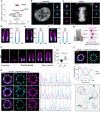
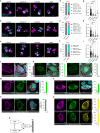

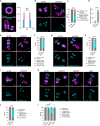
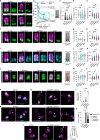
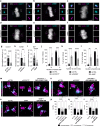
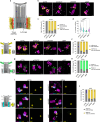

Similar articles
-
A delta-tubulin/epsilon-tubulin/Ted protein complex is required for centriole architecture.Elife. 2025 Mar 11;13:RP98704. doi: 10.7554/eLife.98704. Elife. 2025. PMID: 40067174 Free PMC article.
-
Coordinated roles of the CEP164 homodimer and TTBK2 are required for recruitment of the IFT machinery to the mother centriole for ciliogenesis.Mol Biol Cell. 2025 Jul 1;36(7):ar79. doi: 10.1091/mbc.E24-12-0536. Epub 2025 Apr 30. Mol Biol Cell. 2025. PMID: 40305080
-
WDR90 is a centriolar microtubule wall protein important for centriole architecture integrity.Elife. 2020 Sep 18;9:e57205. doi: 10.7554/eLife.57205. Elife. 2020. PMID: 32946374 Free PMC article.
-
Centriole Duplication at the Crossroads of Cell Cycle Control and Oncogenesis.Cells. 2025 Jul 17;14(14):1094. doi: 10.3390/cells14141094. Cells. 2025. PMID: 40710347 Free PMC article. Review.
-
The Black Book of Psychotropic Dosing and Monitoring.Psychopharmacol Bull. 2024 Jul 8;54(3):8-59. Psychopharmacol Bull. 2024. PMID: 38993656 Free PMC article. Review.
Cited by
-
The Luminal Ring Protein C2CD3 Acts as a Radial In-to-Out Organizer of the Distal Centriole and Appendages.bioRxiv [Preprint]. 2025 Jun 18:2025.06.17.660204. doi: 10.1101/2025.06.17.660204. bioRxiv. 2025. PMID: 40667239 Free PMC article. Preprint.
References
-
- Nigg, E. A. & Raff, J. W. Centrioles, centrosomes, and cilia in health and disease. Cell139, 663–678 (2009). - PubMed
-
- Doxsey, S. Re-evaluating centrosome function. Nat. Rev. Mol. Cell Biol.2, 688–698 (2001). - PubMed
-
- Bettencourt-Dias, M. & Glover, D. M. Centrosome biogenesis and function: centrosomics brings new understanding. Nat. Rev. Mol. Cell Biol.8, 451–463 (2007). - PubMed
-
- Gönczy, P. Centrosomes and cancer: revisiting a long-standing relationship. 10.1038/nrc3995 (2015). - PubMed
-
- Bornens, M. Centrosome Cycle. Life Sci.521, 1–6 (2002).
MeSH terms
Substances
Grants and funding
- 310030_205087/Schweizerischer Nationalfonds zur Förderung der Wissenschaftlichen Forschung (Swiss National Science Foundation)
- PP00P3_187198/Schweizerischer Nationalfonds zur Förderung der Wissenschaftlichen Forschung (Swiss National Science Foundation)
- 310030_205087/Schweizerischer Nationalfonds zur Förderung der Wissenschaftlichen Forschung (Swiss National Science Foundation)
- 715289/EC | EU Framework Programme for Research and Innovation H2020 | H2020 Priority Excellent Science | H2020 European Research Council (H2020 Excellent Science - European Research Council)
- MB22.00075/Federal Department of Economic Affairs, Education and Research, Switzerland | Staatssekretariat für Bildung, Forschung und Innovation (State Secretariat for Education, Research and Innovation)
LinkOut - more resources
Full Text Sources

